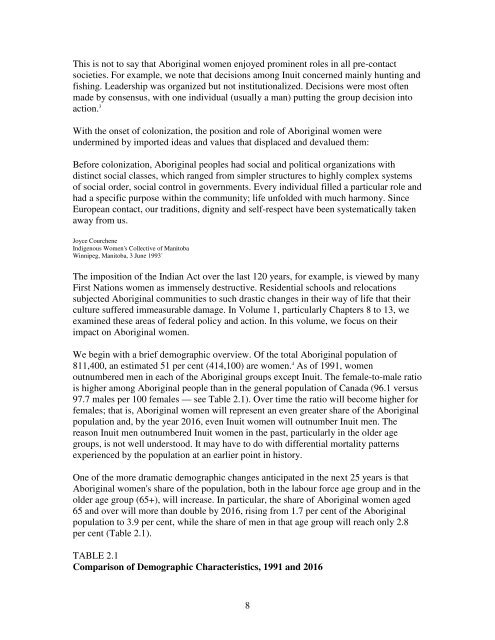2. Women's Perspectives - Christian Aboriginal Infrastructure ...
2. Women's Perspectives - Christian Aboriginal Infrastructure ...
2. Women's Perspectives - Christian Aboriginal Infrastructure ...
You also want an ePaper? Increase the reach of your titles
YUMPU automatically turns print PDFs into web optimized ePapers that Google loves.
This is not to say that <strong>Aboriginal</strong> women enjoyed prominent roles in all pre-contact<br />
societies. For example, we note that decisions among Inuit concerned mainly hunting and<br />
fishing. Leadership was organized but not institutionalized. Decisions were most often<br />
made by consensus, with one individual (usually a man) putting the group decision into<br />
action. 3<br />
With the onset of colonization, the position and role of <strong>Aboriginal</strong> women were<br />
undermined by imported ideas and values that displaced and devalued them:<br />
Before colonization, <strong>Aboriginal</strong> peoples had social and political organizations with<br />
distinct social classes, which ranged from simpler structures to highly complex systems<br />
of social order, social control in governments. Every individual filled a particular role and<br />
had a specific purpose within the community; life unfolded with much harmony. Since<br />
European contact, our traditions, dignity and self-respect have been systematically taken<br />
away from us.<br />
Joyce Courchene<br />
Indigenous <strong>Women's</strong> Collective of Manitoba<br />
Winnipeg, Manitoba, 3 June 1993 *<br />
The imposition of the Indian Act over the last 120 years, for example, is viewed by many<br />
First Nations women as immensely destructive. Residential schools and relocations<br />
subjected <strong>Aboriginal</strong> communities to such drastic changes in their way of life that their<br />
culture suffered immeasurable damage. In Volume 1, particularly Chapters 8 to 13, we<br />
examined these areas of federal policy and action. In this volume, we focus on their<br />
impact on <strong>Aboriginal</strong> women.<br />
We begin with a brief demographic overview. Of the total <strong>Aboriginal</strong> population of<br />
811,400, an estimated 51 per cent (414,100) are women. 4 As of 1991, women<br />
outnumbered men in each of the <strong>Aboriginal</strong> groups except Inuit. The female-to-male ratio<br />
is higher among <strong>Aboriginal</strong> people than in the general population of Canada (96.1 versus<br />
97.7 males per 100 females — see Table <strong>2.</strong>1). Over time the ratio will become higher for<br />
females; that is, <strong>Aboriginal</strong> women will represent an even greater share of the <strong>Aboriginal</strong><br />
population and, by the year 2016, even Inuit women will outnumber Inuit men. The<br />
reason Inuit men outnumbered Inuit women in the past, particularly in the older age<br />
groups, is not well understood. It may have to do with differential mortality patterns<br />
experienced by the population at an earlier point in history.<br />
One of the more dramatic demographic changes anticipated in the next 25 years is that<br />
<strong>Aboriginal</strong> women's share of the population, both in the labour force age group and in the<br />
older age group (65+), will increase. In particular, the share of <strong>Aboriginal</strong> women aged<br />
65 and over will more than double by 2016, rising from 1.7 per cent of the <strong>Aboriginal</strong><br />
population to 3.9 per cent, while the share of men in that age group will reach only <strong>2.</strong>8<br />
per cent (Table <strong>2.</strong>1).<br />
TABLE <strong>2.</strong>1<br />
Comparison of Demographic Characteristics, 1991 and 2016<br />
8
















